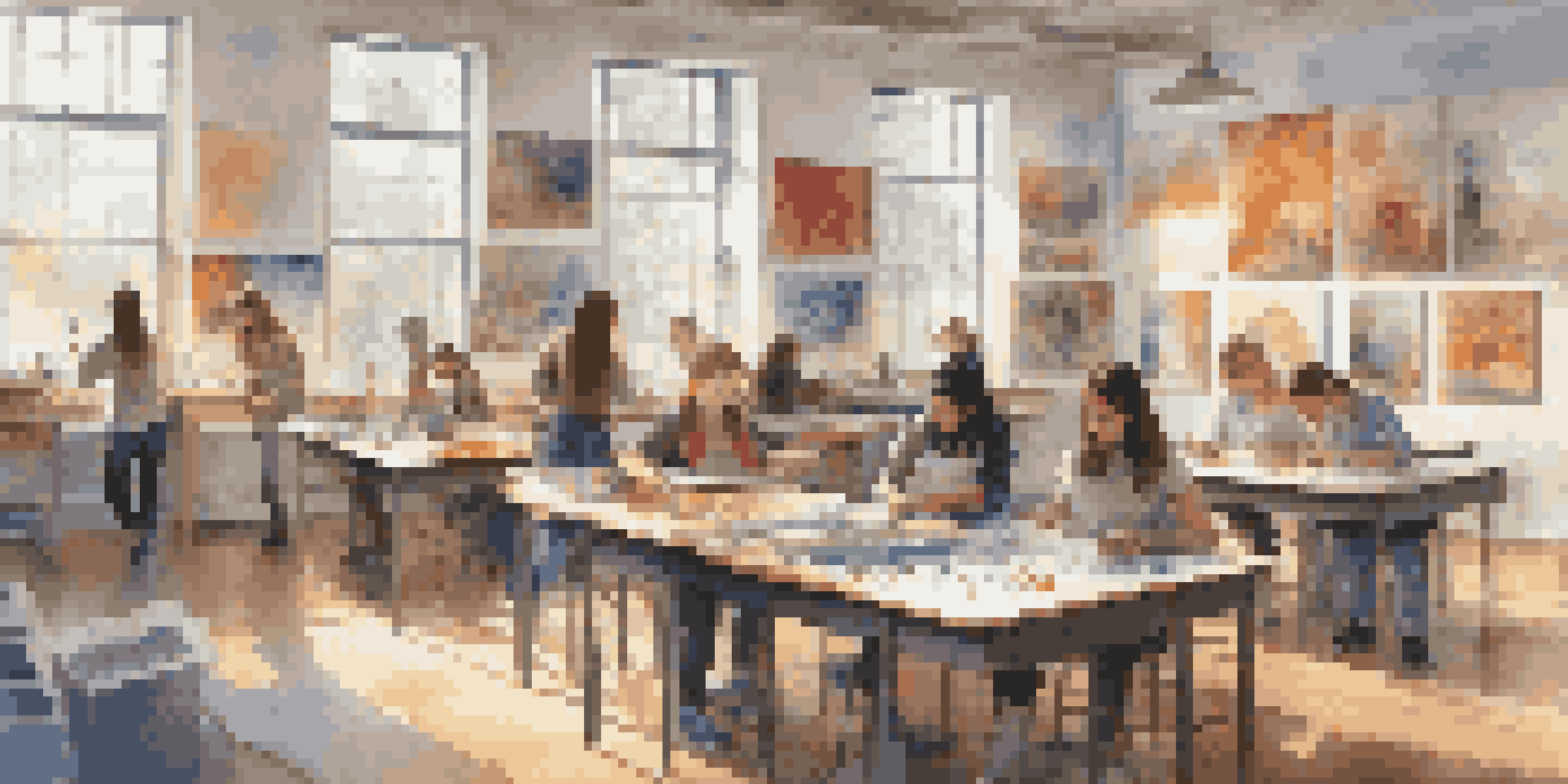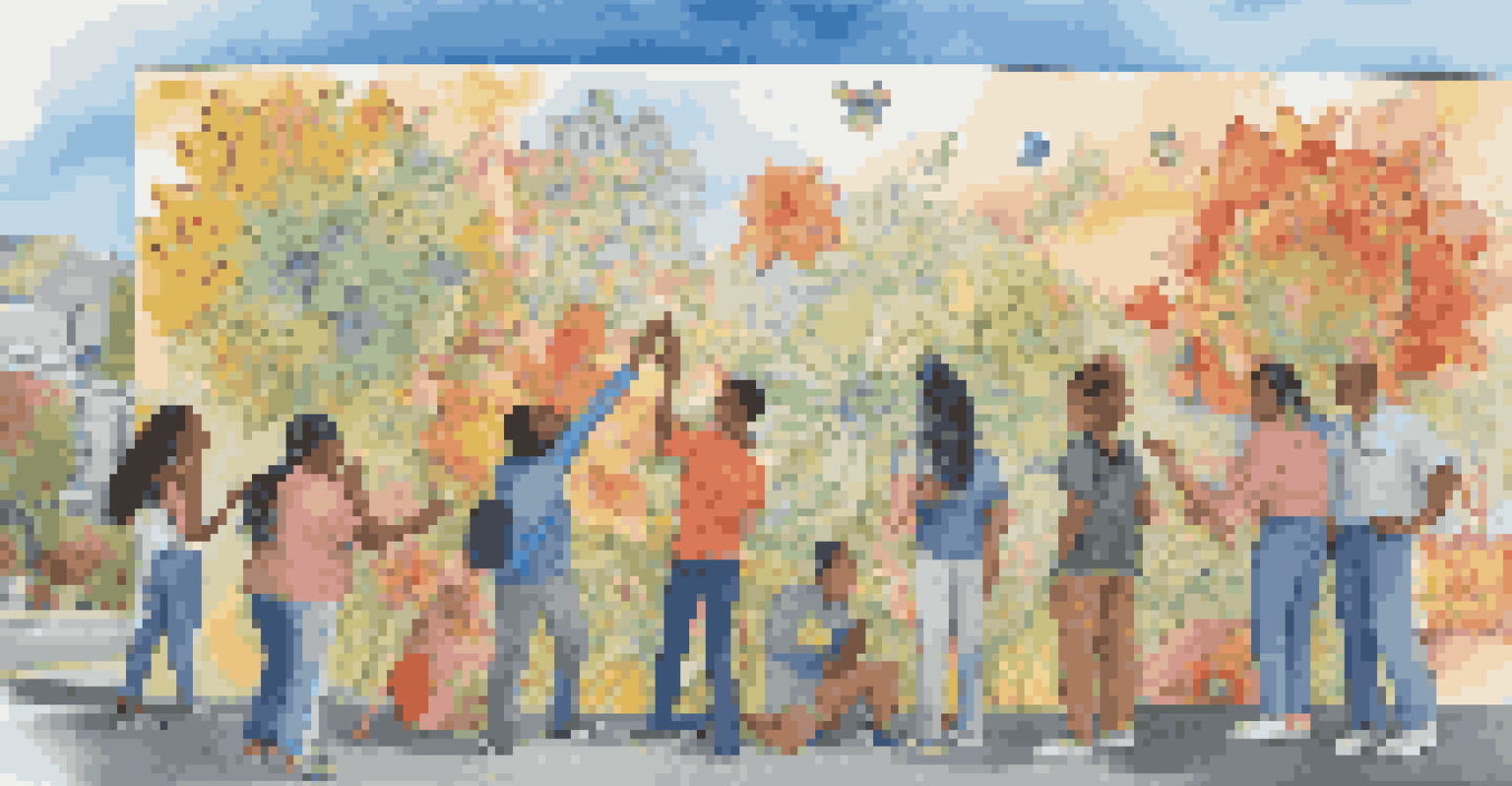Art Education's Role in Shaping Future Innovators

Understanding the Connection Between Art and Innovation
Art education goes beyond just creating beautiful things; it nurtures creativity, critical thinking, and problem-solving skills. When students engage with art, they learn to express ideas and emotions, paving the way for innovative thinking. This connection is crucial because today's problems require out-of-the-box solutions that traditional education often overlooks.
Art enables us to find ourselves and lose ourselves at the same time.
Think about how artists approach a blank canvas. It’s not just about painting; it's about envisioning possibilities. This mindset encourages students to reframe challenges and explore unconventional solutions, making them more adept at tackling future issues. As they create, they learn that there is often no single 'right' answer, a lesson that's invaluable in any innovative field.
Ultimately, art education empowers students to harness their imagination, making them more agile thinkers. In a world that constantly evolves, this ability to adapt and innovate is what will set future leaders apart.
Fostering Emotional Intelligence Through Art
Emotional intelligence, or EQ, is essential for effective leadership and teamwork. Art education plays a significant role in developing this skill by encouraging students to express and understand their feelings. Through activities like painting, sculpting, or performing, students learn to communicate emotions, both their own and those of others.

For instance, when students critique a peer's artwork, they practice giving constructive feedback while developing empathy. This not only strengthens their interpersonal skills but also enhances their capacity to collaborate in diverse teams. In innovation-driven workplaces, these soft skills are just as vital as technical knowledge.
Art Fuels Creativity and Innovation
Art education nurtures creativity and critical thinking, essential for developing innovative solutions to modern challenges.
By cultivating emotional intelligence through art, students become more aware of their emotions and those of others, fostering a supportive environment for collaboration. This emotional awareness is a cornerstone of successful innovation, where understanding different perspectives can lead to breakthrough ideas.
Encouraging Risk-Taking and Resilience
Art education teaches students that failure is often a part of the creative process. In art, mistakes can lead to unexpected and exciting outcomes, encouraging students to take risks. This culture of experimentation fosters resilience, as students learn to bounce back from setbacks and view challenges as opportunities for growth.
Every artist was first an amateur.
For example, a student may start with a vision for a painting, but the outcome may not match their expectations. Instead of giving up, they learn to adapt and find beauty in the unexpected. This mindset is crucial for future innovators who will face numerous obstacles and failures on their journey.
By embracing risk-taking and resilience, students become more confident in their abilities to innovate. They learn that each failure is a stepping stone toward success, a lesson that will serve them well in any field they choose to pursue.
Developing Critical Thinking Skills
Art education encourages students to analyze, interpret, and evaluate different forms of expression, enhancing their critical thinking skills. When students critique artworks or create their own, they engage in a reflective process that sharpens their ability to assess information critically. This analytical mindset is essential for innovation, where evaluating ideas and concepts is key.
For instance, a student studying a piece of abstract art must consider the emotions it evokes and the techniques used. This evaluation process mirrors the analytical skills required in science, technology, and business, where assessing data and making informed decisions is vital.
Emotional Intelligence Through Art
Engaging in art helps students build emotional intelligence, fostering empathy and collaboration vital for teamwork in any field.
By honing their critical thinking skills through art, students become better equipped to approach problems from various angles. This multifaceted perspective is invaluable in innovation, where the best solutions often arise from considering multiple viewpoints.
Enhancing Collaboration Through Group Projects
Art education often involves collaborative projects, where students work together to create something meaningful. These experiences teach students the value of teamwork and the importance of diverse perspectives, essential components of innovation. When students collaborate, they learn to listen, negotiate, and compromise, skills that are crucial in any professional environment.
Imagine a group of students tasked with creating a mural. Each member brings unique ideas and skills to the table, and through collaboration, they create something greater than the sum of its parts. This experience mirrors how innovative teams function in the real world, where collaboration can lead to groundbreaking ideas.
By engaging in collaborative projects, students not only improve their artistic skills but also prepare themselves for future roles in workplaces that thrive on teamwork. This preparedness is critical as innovation increasingly relies on collective effort and shared creativity.
Integrating Technology with Art Education
In today's digital age, integrating technology into art education is essential for preparing students to innovate. Tools like digital painting software, video editing programs, and 3D modeling applications allow students to explore new mediums and expand their creative horizons. This fusion of art and technology equips students with skills that are increasingly valuable in various industries.
For example, a student proficient in graphic design software can create stunning visuals for a marketing campaign, showcasing how art can intersect with business. This integration not only enhances students' artistic capabilities but also prepares them for careers in fields where creativity and technology converge.
Collaboration Enhances Learning
Group art projects teach teamwork and diverse perspectives, preparing students for collaborative innovation in professional settings.
By embracing technology in art education, students become versatile creators who can adapt to the demands of a rapidly changing job market. This adaptability is key to driving innovation in an increasingly digital world.
The Role of Art Education in Global Perspectives
Art education exposes students to diverse cultures and perspectives, fostering a global mindset. Through studying art from different regions and eras, students gain insights into various ways of thinking and problem-solving. This exposure is vital for innovation, as it encourages students to draw inspiration from a wide range of sources.
For instance, exploring indigenous art can teach students about sustainable practices and community engagement. These lessons can inspire future innovators to create solutions that are not only effective but also culturally sensitive and inclusive.

By embracing global perspectives through art, students become more open-minded thinkers who appreciate diversity. This openness is essential for innovation, where drawing on a variety of influences can lead to unique and groundbreaking ideas.
Conclusion: Art Education as a Catalyst for Innovation
In conclusion, art education plays a pivotal role in shaping future innovators by fostering creativity, emotional intelligence, resilience, and critical thinking. It encourages students to collaborate, embrace technology, and appreciate diverse perspectives, all of which are essential for success in today's rapidly evolving world. As we continue to navigate complex challenges, cultivating these skills through art education will be vital.
By prioritizing art education, we not only enrich students' lives but also equip them with the tools necessary to become the innovators of tomorrow. This investment in creativity and imagination will pay off, not just for individuals, but for society as a whole.
As we move forward, let us recognize the transformative power of art education and its ability to inspire the next generation of thinkers, creators, and problem-solvers. After all, the future belongs to those who dare to dream and innovate.